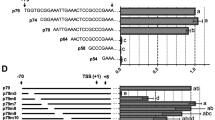Summary
Alpha-1 tubulin is the principal alpha-tubulin isotype found in the flagella of the unicellular green alga, Chlamydomonas reinhardii. Although the pattern of tubulin mRNA accumulation and utilization has been examined in some detail in Chlamydomonas (Lefebvre and Rosenbaum 1986), the transcriptional mechanisms establishing tubulin mRNA levels are not understood. To begin an analysis of the alpha-1 tubulin gene transcriptional control elements, we studied a number of promoter mutants of this gene from Chlamydomonas. These mutants, assayed by injection into Xenopus oocyte nuclei, delimit the promoter to 36 bp of DNA upstream of the cap site and 73 bp of the untranslated mRNA leader. A major rate-controlling element lies in a short GC-rich sequence positioned between the TATA homology and the mRNA cap site (position+1). A similar sequence motif has been found in the same position upstream of all four tubulin genes of Chlamydomonas (Brunke et al. 1984). A 10 bp linker insertion within this sequence abolishes transcription. A far upstream sequence, located in a fragment between-400 and-800, is an efficiency element, whose deletion inhibits transcription in vivo by about 30%. The upstream element (ue) also has the unique ability to drive RNA polymerase II (RNAPII) transcription in vivo when isolated from all downstream promoter elements, unlike any control element described to date. These results suggest that a sequence within the upstream element is an entry site for RNAPII into the tubulin transcription unit.
Similar content being viewed by others
Abbreviations
- RNAPII:
-
RNA polymerase II (RNA polymerase B)
- ue :
-
Chlamydomonas alpha-tubulin gene upstream element (-400 to-800)
- numbering of promoter DNA:
-
+1 is designated as the mRNA start site, or the cap site
References
Ares M Jr, Howell SH (1982) Cell-cycle stage-specific accumulation of mRNAs encoding tubulin and other polypeptides in Chlamydomonas. Proc Natl Acad Sci USA 79: 5577–5581
Baker EJ, Schloss JA, Rosenbaum JR (1984) Rapid changes in tubulin RNA synthesis and stability induced by deflagellation in Chlamydomonas. J Cell Biol 99:2074–2081
Baker EJ, Keller LR, Schloss JA, Rosenbaum JR (1986) Protein synthesis is required for rapid degradation of tubulin mRNA and other deflagellation-induced RNAs in Chlamydomonas. Mol Cell Biol 6:54–61
Bandziulis R (1987) Thesis. Yale University, New Haven, Connecticut
Banerji J, Rusconi S, Schaffner W (1981) Expression of a β-globin gene is enhanced by remote SV40 DNA sequences. Cell 27:299–308
Brunke KJ, Anthony JG Sternberg EJ, Weeks DP (1984) Repeated consensus sequence and pseudopromoters in the four coordinately regulated tubulin genes of Chlamydomonas reinhardii. Mol Cell Biol 4:1115–1124
Cleveland DW, Sullivan KF (1985) Molecular biology and genetics of tubulin. Annu Rev Biochem 54:331–365
Coen DM, Weinheimer SP, McKnight SL (1986) A genetic approach to promoter recognition during transinduction of viral gene expression. Science 234:53–58
Dynan WS, Tjian R (1983) The promoter-specific transcription factor Sp1 binds to upstream sequences in the SV40 early promoter. Cell 35:79–87
Gilmour DS, Lis JT (1985) In vivo interactions of RNA polymerase II with genes of Drosophila melanogaster. Mol Cell Biol 5:2009–2018
Gilmour DS, Lis JT (1986) RNA polymerase II interacts with the promoter region of the noninduced hsp 70 gene in Drosophila melanogaster cells. Mol Cell Biol 6:3984–3989
Gorman C, Moffat LF, Howard BH (1982) Recombinant genomes which express chloramphenicol acetyltransferase in mammalian cells. Mol Cell Biol 2:1044–1051
Graves BJ, Eisenman RN, McKnight SL (1985) Delineation of transcriptional control signals within the Moloney murine sarcoma virus long terminal repeat. Mol Cell Biol 5:1948–1958
Hall C, Jacob P, Ringold G, Lee F (1983) Expression and regulation of Escherichia coli lacZ gene fusions in mammalian cells. J Mol Appl Genet 2:101–109
Jerbomel P, Bourachot B, Yaniv M (1984) Two distinct enhancers with different cell specificities coexist in the regulatory region of polyoma. Cell 39:653–662
Jones H, Richter J, Weeks D, Smith LD (1983) Regulation of adenovirus transcription by an E1a gene in microinjected Xenopus laevis oocytes. Mol Cell Biol 3:2131–2142
Kadonaga JT, Tjian R (1986) Affinity purification of sequencespecific DNA binding proteins. Proc Natl Acad Sci USA 83:5889–5893
Keller LR, Schloss JA, Silflow CD, Rosenbaum JL (1984) Transcription of tubulin genes in vitro in isolated Chlamydomonas nuclei. J Cell Biol 98:1138–1143
Kressman A, Clarkson S, Telford J, Birnstiel ML (1978) Transcription of Xenopus tDNA and sea urchin histone DNA injected into Xenopus oocyte nucleus. Cold spring Harbor Symp Quant Biol 42:1077–1082
Lefebvre PA, Rosenbaum JL (1986) Regulation of the synthesis and assembly of ciliary and flagellar proteins during regeneration. Annu Rev Cell Biol 2:517–546
L'Hernault SW, Rosenbaum JL (1983) Chlamydomonas alpha-tubulin is post-translationally modified in the flagella during flagellar assembly. J Cell Biol 97:258–263
Maniatis T, Fritsch EF, Sambrook J (1982) Molecular cloning: A laboratory manual. Cold spring Harbor Laboratory
Matsui T, Segall J, Weil PA, Roeder R (1980) Multiple factors required for accurate initiation of transcription by purified RNA polymerase II. J Biol Chem 255:11992–11996
Mayfield SP, Fahire M, Frank G, Zuber H, Rochaix J-D (1987) Expression of the nuclear gene encoding oxygen-evolving enhancer protein 2 is required for high levels of photosynthetic oxygen evolution in Chlamydomonas reinhardtii. Proc Natl Acad Sci USA 84:749–753
Minami SA, Collis PS, Young EE, Weeks DP (1981) Tubulin induction in C. reinhardii: Requirement for tubulin mRNA synthesis. Cell 24:89–95
Schloss JA, Silflow CD, Rosenbaum JL (1984) mRNA abundance changes during flagellar regneration in Chlamydomonas. Mol Cell Biol 4:424–434
Silflow CD, Rosenbaum JL (1981) Multiple alpha-and beta-tubulin genes in Chlamydomonas and regulation of tubulin mRNA levels after deflagellation. Cell 24:81–88
Silflow CD, Chisolm RL, Conner TW, Ranum LPW (1985) The two alpha-tubulin genes of Chlamydomonas reinhardii code for slightly different proteins. Mol Cell Biol 5:2389–2398
Zinn K, DiMaio D, Maniatis T (1983) Identification of two distinct regulatory regions adjacent to the human beta-interferon gene. Cell 34:865–879
Author information
Authors and Affiliations
Additional information
Communicated by E. Bautz
Rights and permissions
About this article
Cite this article
Bandziulis, R.J., Rosenbaum, J.L. Novel control elements in the alpha-1 tubulin gene promoter from Chlamydomonas reinhardii . Mol Gen Genet 214, 204–212 (1988). https://doi.org/10.1007/BF00337712
Received:
Issue Date:
DOI: https://doi.org/10.1007/BF00337712




